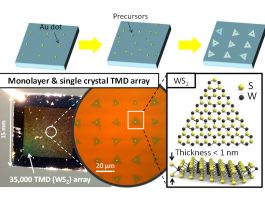The Koleilat Research Group is working to make perovskite solar cells greener so that they can be deployed around the world to provide safe and renewable energy.
When Ghada Koleilat transferred from the American University of Beirut in Lebanon to Concordia University in Montreal in 2004, she quickly rediscovered her passion for engineering and science. While majoring in electrical engineering, she sub-specialised in electronics and immersed herself in semiconductor physics. Semiconductors, materials that have conductivity between insulators and most metals, are essential components of electronics ranging from solar cells to LEDs, lasers, and a variety of other devices that can react to and manipulate light. After Concordia, Koleilat pursued her MASc (2008) and PhD (2012) at the University of Toronto, which helped her develop into an exceptional researcher.
Solar cells
Solar cells are devices that convert the Sun’s energy to electricity we can use. There are several emerging solar cell technologies including quantum dots, organics, and perovskites that aim to revolutionise the semiconductor industry. Overall, the electrical properties and stability of these emerging technologies must be improved to allow widespread commercialisation. During her graduate studies, Koleilat made great progress in the quantum dot solar cell area through her development of the world’s first functional quantum dot tandem solar cell that employs a single quantum tuned material. Not stopping there, she designed a new processing method that enables improved electrical properties and prolonged stability in quantum dot solar cells, and she used this novel method to build remarkable solar cells.
Previously, these types of devices degraded within minutes of air exposure. Koleilat shattered the established performance record for this new class of materials using skill and determination. Her initial published article now has more than 400 citations and was one of the 10 most-cited ACS Nano articles for four years in a row. The process she developed is now patented and licensed to InVisage, Inc, which was recently sold to Apple.
The Koleilat Research Group
Koleilat is the recipient of several prestigious, highly competitive awards for her research, most notably the Banting Postdoctoral Fellowship (2012). As a prestigious Banting Fellow, she did her postdoctoral training at Stanford University and investigated the properties of single-walled carbon nanotubes (an organic material) and their potential in solar cells. She joined Dalhousie University in August 2016, where she is cross-appointed in three departments: Electrical and Computer Engineering, Process Engineering and Applied Science, and Physics and Atmospheric Science.
She started the Koleilat Research Group to develop a state-of-the-art laboratory for carbon-based energy converters and light interactive electronic textiles. The team utilises expertise from electrical, chemical, mechanical and materials engineering, as well as physics and chemistry, to make breakthroughs in these areas. As an independent investigator, Koleilat was recently awarded the inaugural New Frontiers in Research fund in the Exploration stream to investigate self-repairing solar cells.
The Koleilat Group features many skilled and driven students. Alireza Ghodrat is pursuing a Master’s degree in Chemical Engineering and is researching the development of light interactive electronic textiles for the healthcare industry. Another Master’s student in Chemical Engineering, Benjamin Smith, a recipient of the Pengrowth Innovation Grant, is using his background in materials engineering to investigate solvent engineering in perovskite materials (a semiconducting material with the same crystal structure as calcium titanium oxide). Rashad Kahwagi, a PhD student in the group, is researching flexible power generators. The group also features several talented undergraduate students including electrical engineering student Kyle Brisebois, who is interested in the characterisation of solar cells and other electronics, and Rania Elsebai, who is researching novel materials for energy conversion. Finally, Sean Thornton, a PhD student in the group who is the recipient of the Dr Robert Gillespie Graduate Scholarship and the Bruce and Dorothy Rosetti Engineering Research Scholarship, is researching green perovskite solar cells.
The importance of renewables
Energy demand is expected to continue to increase globally by as much as 50% by 2050. Furthermore, a great number of people (13% of the global population) still do not have access to energy, particularly in developing countries and remote areas. Providing energy to people will greatly enhance their quality of life, because energy is required to power hospitals, water treatment plants, lights, and transportation, among other things.
Currently, about 80% of the world’s energy consumption comes from fossil fuels. Evidently, this is a problem because fossil fuels are non-renewable and cause environmental pollution. To satisfy the ever-growing demands for energy globally, renewable energy sources are the key. There are many important renewable energy sources such as wind, geothermal, and hydro; but the most promising source of energy is something accessible in all areas of the planet: the Sun. It is so powerful that it provides enough energy in one hour to meet the world’s annual energy demand.
Perovskite solar cells
Deploying cheap, clean, and high performing solar energy sources to people all over the world will be the next great leap forward for humanity. Typical solar cells employing silicon are expensive and their construction is energy intensive. Perovskite solar cells have tremendous potential to greatly expand the harnessing of solar energy, and they are cheap and easily created. In addition, despite being a relatively new area of research as a solar energy material, perovskite solar cells can already harness the power of the Sun nearly as efficiently as conventional solar cells.
Remarkably, perovskite is solution processed, can cover large areas easily, and can work in conjunction with conventional solar cells. Furthermore, by incorporating a flexible organic molecule into the mixture, perovskite solar cells can become self-repairing. Currently, the most efficient perovskite solar cell is not environmentally friendly because it uses the heavy metal lead (Pb), which is insidiously toxic and needs replacement.
Sean Thornton, under the supervision of Ghada Koleilat, is focusing on making perovskite green by replacing the lead with benign chemicals like tin (Sn) or antimony (Sb). Using a novel blade coating deposition method that is also used in the field of organic polymers, repeatable self-repairing green perovskite solar cells will be created. The organic cation necessary for flexibility will be engineered by another PhD student with a background in chemistry, Mal Hedrick, and the solar cells will be efficiently tested relying on the electrical engineering expertise in the group. Device performance tests along the way will feed back into the material engineering approaches developed by the team, accelerating innovation.
Once green perovskite solar cells are successfully developed, they can be deployed in many places around the world and greatly increase the amount of green energy that is produced. This will be a major step forward towards making green energy accessible to everyone.
Dr Ghada Koleilat
Assistant Professor
Koleilat Research Group
Department of Process Engineering and Applied Science
Dalhousie University
+1 (902) 494 4177
ghada.koleilat@dal.ca
www.koleilatresearchgroup.com





